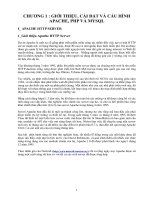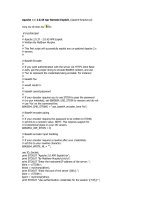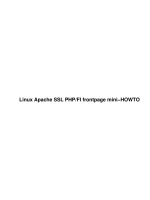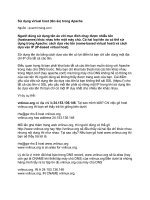apache tomcat 7
Bạn đang xem bản rút gọn của tài liệu. Xem và tải ngay bản đầy đủ của tài liệu tại đây (4.35 MB, 287 trang )
www.it-ebooks.info
Apache Tomcat 7
Aleksa Vukotic
James Goodwill
www.it-ebooks.info
Apache Tomcat 7
Copyright © 2011 by Aleksa Vukotic and James Goodwill
All rights reserved. No part of this work may be reproduced or transmitted in any form or by any means,
electronic or mechanical, including photocopying, recording, or by any information storage or retrieval
system, without the prior written permission of the copyright owner and the publisher.
ISBN-13 (pbk): 978-1-4302-3723-5
ISBN-13 (electronic): 978-1-4302-3724-2
Trademarked names, logos, and images may appear in this book. Rather than use a trademark symbol
with every occurrence of a trademarked name, logo, or image we use the names, logos, and images only
in an editorial fashion and to the benefit of the trademark owner, with no intention of infringement of
the trademark.
The use in this publication of trade names, trademarks, service marks, and similar terms, even if they are
not identified as such, is not to be taken as an expression of opinion as to whether or not they are subject
to proprietary rights.
President and Publisher: Paul Manning
Lead Editor: Chris Nelson
Technical Reviewer: Chád Darby
Editorial Board: Steve Anglin, Mark Beckner, Ewan Buckingham, Gary Cornell, Jonathan Gennick,
Jonathan Hassell, Michelle Lowman, James Markham, Matthew Moodie, Jeff Olson, Jeffrey
Pepper, Frank Pohlmann, Douglas Pundick, Ben Renow-Clarke, Dominic Shakeshaft, Matt
Wade, Tom Welsh
Coordinating Editor: Corbin Collins
Copy Editor: Tracy Brown
Compositor: Bytheway Publishing Services
Indexer: SPI Global
Artist: SPI Global
Cover Designer: Anna Ishchenko
Distributed to the book trade worldwide by Springer Science+Business Media, LLC., 233 Spring Street,
6th Floor, New York, NY 10013. Phone 1-800-SPRINGER, fax (201) 348-4505, e-mail orders-ny@springer-
sbm.com, or visit www.springeronline.com.
For information on translations, please e-mail , or visit www.apress.com.
Apress and friends of ED books may be purchased in bulk for academic, corporate, or promotional use.
eBook versions and licenses are also available for most titles. For more information, reference our
Special Bulk Sales–eBook Licensing web page at www.apress.com/bulk-sales.
The information in this book is distributed on an “as is” basis, without warranty. Although every
precaution has been taken in the preparation of this work, neither the author(s) nor Apress shall have
any liability to any person or entity with respect to any loss or damage caused or alleged to be caused
directly or indirectly by the information contained in this work.
The source code shown in this book is available to readers at apress.com. You will need to answer
questions pertaining to this book in order to successfully download the code.
www.it-ebooks.info
To Jelica
–Aleksa Vukotic
www.it-ebooks.info
iv
Contents at a Glance
About the Authors xiii
About the Technical Reviewer xiv
Acknowledgments xv
Preface xvi
Chapter 1: Introduction to Apache Tomcat 7 1
Chapter 2: Deploying Web Applications to Tomcat 17
Chapter 3: Servlets, JSPs and ServletContext 47
Chapter 4: Using Tomcat’s Manager Web Application 73
Chapter 5: HTTP Sessions 95
Chapter 6: Configuring Security Realms 119
Chapter 7: Securing Tomcat with SSL 141
Chapter 8: Valves and Servlet Filters 155
Chapter 9: Embedding Tomcat 175
Chapter 10: Integrating Apache Web Server 185
Chapter 11: Integrating Spring MVC Framework 199
Chapter 12: Logging in Tomcat 211
Chapter 13: Configuring JNDI in Tomcat 229
Appendix A: Server.xml File 247
Appendix B: The Web.xml File 261
Index 273
www.it-ebooks.info
v
Contents
About the Authors xiii
About the Technical Reviewer xiv
Acknowledgments xv
Preface xvi
Chapter 1: Introduction to Apache Tomcat 7 1
The Apache Tomcat Server 1
The Tomcat Manager Web Application 2
Specialized Realm Implementations 2
Tomcat Valves 2
Further Information 2
The Architecture of Tomcat 3
The Server 5
The Service 5
The Connector 6
The Engine 6
The Host 6
The Context 6
Installing and Configuring Tomcat 6
Requirements for Installing and Configuring Tomcat 6
Installing Tomcat Using Windows Service Installer 7
Manually Installing on Windows 8
Installing to Linux 11
www.it-ebooks.info
CONTENTS
vi
Testing Your Tomcat Installation 12
Summary 15
Chapter 2: Deploying Web Applications to Tomcat 17
The Tomcat Directory Structure 17
Executing Tomcat scripts 18
Passing Runtime Options to Catalina Script 19
Tomcat Configuration Files 20
Java Web Applications 20
The Directory Structure 21
The Deployment Descriptor 22
Manually Deploying Web Applications to Tomcat 23
Creating the Web Application Directory Structure 24
Adding Static Content 24
Adding JSPs 25
Adding Servlets 27
Deploying WAR Archive 30
Other Methods of Deployment 32
Configuring Hosts and Contexts 32
Configuring Hosts 32
Configuring Web Application Contexts 33
Deploying a Web Application from Eclipse IDE 37
Updating Eclipse for Java Web Development 37
Creating a Dynamic Web Project 39
Adding Tomcat Runtime Environment 41
Deploying a Java Web Project to Tomcat from Eclipse 43
Summary 45
www.it-ebooks.info
CONTENTS
vii
Chapter 3: Servlets, JSPs and ServletContext 47
Servlets 47
The Lifecycle of a Servlet 48
ServletRequest and ServletResponse 49
The GenericServlet and HttpServlet Classes 51
Configuring a Servlet in a Servlet Container 53
Servlet API 3.0 55
Java Server Pages 58
Lifecycle of Java Server Pages 59
The Components of a Java Server Pages 60
JSP Directives 61
JSP Scripting 63
Relationship Between Servlets and ServletContext 69
Summary 70
Chapter 4: Using Tomcat’s Manager Web Application 73
What Is the Manager Web Application? 73
Gaining Access to the Manager Web Application 74
Accessing the Manager Web Application Using Web Interface 76
Listing Deployed Web Applications 78
Checking Server Status 79
Deploying a New Web Application 80
Reloading an Existing Web Application 83
Sessions 84
Stop 86
Start 88
Undeploy 89
www.it-ebooks.info
CONTENTS
viii
Using a Text-Based Interface to Access Manager Web Application 90
Installing Ant 90
Configuring Tomcat’s Ant Tasks 91
Running Ant Scripts 93
Summary 94
Chapter 5: HTTP Sessions 95
The Servlet Implementation of HTTP sessions 97
Shopping Basket Session Example 99
Invalidating a Session 107
Session Management in Tomcat 108
StandardManager 109
PersistentManager 112
Summary 118
Chapter 6: Configuring Security Realms 119
Security Realms 119
MemoryRealm 120
Protecting a Resource with a MemoryRealm 121
Protection Against Brute Force Attacks 126
UserDatabaseRealm 127
JDBC Realms 128
Creating the Users Database 128
Configuring Tomcat to Use a JDBCRealm 131
Configuring FORM-Based Authentication with JDBCRealm 132
DataSourceRealm 136
The Benefits of Using a JDBCRealm 137
JNDIRealm 138
www.it-ebooks.info
CONTENTS
ix
Accessing an Authenticated User 139
Summary 140
Chapter 7: Securing Tomcat with SSL 141
Introduction to SSL 141
What SSL Does 142
How SSL works 142
Configuring Tomcat with SSL 144
Creating Keystore with SSL Certificate 144
Configuring Tomcat’s SSL Connector 147
Configuring Secure Resources in the Web Application 149
Installing a Certificate from the Certificate Authority 151
Secure Session Tracking with Tomcat 152
Summary 154
Chapter 8: Valves and Servlet Filters 155
Introduction to Valves and Filters 155
What Is a Tomcat Valve? 156
What Is a Servlet Filter? 156
Tomcat Valves vs. Servlet Filters 157
Configuring Tomcat Valves 157
Implementing a Custom Valve 157
The Access Log Valve 159
The Remote Address Valve 162
Crawler Session Manager Valve 163
Dead Thread Detection Valve 164
Configuring Servlet Filters 164
Implementing a Servlet Filter 165
Request Dumper Filter 168
www.it-ebooks.info
CONTENTS
x
Expires Filter 169
Cross-Site Request Forgery Prevention Filter 171
Summary 173
Chapter 9: Embedding Tomcat 175
Requirements for Embedding Tomcat 175
Embedded Tomcat Java Components 177
Implementing a Sample Application with Embedded Tomcat 178
Testing Servlets with Embedded Tomcat 182
Summary 184
Chapter 10: Integrating Apache Web Server 185
What Is the Apache Web Server? 185
Integrating Tomcat and Apache Web Server 186
Using mod_proxy 187
Using mod_jk 192
Which Approach to Use 195
Load Balancing 195
Summary 197
Chapter 11: Integrating Spring MVC Framework 199
Introducing Spring MVC 199
Spring Framework Overview 199
MVC Pattern 200
Front Controller Pattern 202
Spring MVC Web Applications 203
Configuring DispatcherServlet 204
Adding Views 205
Implementing Controllers 205
www.it-ebooks.info
CONTENTS
xi
Wiring Spring Application Context 206
Summary 209
Chapter 12: Logging in Tomcat 211
Using Tomcat’s JULI Logging Library 211
Introduction to Java Logging and JULI libraries 212
Configuring Internal Tomcat Logging with JULI 217
Configuring Web Application Logging with JULI 219
Using Log4j Library for Web Application Logging 221
PatternLayout 223
Using Log4j for Tomcat Internal Logging 224
Using Log4j for Web Application Logging 225
Web Application Logging Using Slf4j Library 226
Using Slf4j 226
Summary 228
Chapter 13: Configuring JNDI in Tomcat 229
Introduction to JNDI 229
JNDI API Overview 230
Tomcat JNDI Configuration 231
Configuring the Database Connection 232
Introducing JDBC 232
Configuring Data Source as a JNDI Resource 235
Configuring Mail Session 240
Introducing JavaMail 240
Configuring Mail Session as a JNDI Resource 242
Summary 246
Appendix A: Server.xml File 247
Containers 247
www.it-ebooks.info
CONTENTS
xii
The Server Container 247
The Service Container 248
The Engine Container 249
The Host Container 250
The Context Container 252
Connectors 255
The HTTP Connector 257
The AJP Connector 258
Summary 259
Appendix B: The Web.xml File 261
The Basic web.xml Configuration 261
Adding a Servlet Definition 262
Adding a Servlet Mapping 263
Configuring a Servlet Using Annotations 263
Adding a Servlet Filter 264
Configuring Filter Mapping 265
Configuring Servlet Filter Using Annotations 266
Configuring ServletContext Parameters 267
Configuring the Session 267
Adding a Welcome File List 267
Configuring Error Handlers 268
Configuring Mime Types 268
Configuring Web Application Security 268
Adding a Security Constraint 268
Adding a Login Config 270
Summary 271
Index 273
www.it-ebooks.info
xiii
About the Authors
■ Aleksa Vukotic is a keen agile advocate, author, trainer, software architect,
and developer, and has years of experience leading successful deliveries of
business critical software projects.
He has a track record of success with the agile transformation of large
companies, helping senior management lead the way in turning business
requirements into effective software products. Aleksa has vast experience with
Java technologies, and has been involved with the Spring Framework since the
early days, becoming an expert in enterprise Java development with Spring,
along with other open-source technologies. In addition to his Java EE
expertise, Aleksa often utilizes his problem-solving skills to tackle the most
complex issues that arise with projects. This combination of high-level
management skills and technical knowledge has made Aleksa invaluable in
motivating software teams to bring out the best in themselves and make rapid
progress toward successful project delivery. His experience includes working with large and small teams
on all levels—from high-level management, planning, and architecture to low-level technical
implementation of critical software components. Aleksa co-authored Pro Spring 2.5, published by
Apress, and has had several articles published in respected open-source publications. Aleksa is currently
working at Open Credo, a London-based company of technical experts specializing in maximizing
software development value for its clients. Outside of the working environment, Aleksa enjoys following
football and exploring the latest technology gadgets.
■ James Goodwill James Goodwill is an eight-time published author on
leading technologies such as Java Servlets, JavaServer Pages (JSPs), Tomcat,
and Struts. He is a senior enterprise iOS and Java consultant in the Denver
metro area and a frequent speaker and article writer. You can follow James on
Twitter at jamesgoodwill.
www.it-ebooks.info
xiv
About the Technical Reviewer
■ Chád Darby is an author, instructor, and speaker in the Java development
world. As a recognized authority on Java applications and architectures, he
has presented technical sessions at software development conferences
worldwide. In his 15 years as a professional software architect, he’s had the
opportunity to work for Blue Cross/Blue Shield, Merck, Boeing, Northrop
Grumman, and other IT companies.
Chád is a contributing author to several Java books, including
Professional Java E-Commerce (Wrox Press), Beginning Java Networking
(Wrox Press), and XML and Web Services Unleashed (Sams, 2002). He is also
the author of numerous magazine articles for the Java Developer’s Journal
(Sys-Con Publishing).
Chád has Java certifications from Sun Microsystems and IBM. He
holds a B.S. in Computer Science from Carnegie Mellon University. In his free
time, Chád enjoys running half-marathons.
www.it-ebooks.info
xv
Acknowledgments
I would like to thank Jelica, for standing beside me during the writing of this book. Without her support
and encouragement, completing this book would have been a much more difficult task.
I’d also like to thank my parents for providing me with the life guidance that enabled me to be
where I am.
I would like to express my gratitude to all the people helping me to make this book better: Chád
Darby, who helped to achieve a higher technical standard for this book; Chris Nelson, who patiently
helped me improve my writing style and make the book read better with his excellent editorial skills;
Corbin Collins, Steve Anglin, and everyone else at Apress for all the hard work they did to get this book
published.
Big thanks to all who contribute to the Apache Tomcat project and other open-source software
for being part of a community that creates such great products.
And finally, I’d like to thank all my colleagues and friends with whom I’ve worked throughout
my career, for contributing to my professional development, which prepared me to be co-author of this
book.
—Aleksa Vukotic
www.it-ebooks.info
xvi
Preface
The first edition of this book covered the then-new Jakarta Tomcat 4. Tomcat has come a long way from
there, becoming Apache Tomcat in the process, with version 7 released in January 2011. During this
time, Tomcat has become the most popular and used Java servlet container on the market. Other open
source application servers also have started using Tomcat as their embedded servlet engine. With the
shift of focus in enterprise Java development toward more lightweight architecture and tools, Tomcat
has grown to become the deployment platform of choice for business-critical enterprise Java
applications.
This edition has been revised to cover the latest features of Apache Tomcat 7 and Servlet API
3.0. In the world of technology, changes are introduced quickly, and yesterday’s new ideas are the legacy
systems of tomorrow. Although Tomcat is still a leading open source servlet container, a lot has changed
in Java web technologies since version 4. The biggest change was Java Servlet specification, which
advanced to version 3.0, bringing a lot of new features along the way.
This book is based on the original text by James Goodwill, and the concepts and structure of the
original book have been kept where possible. However, where the changes to Tomcat architecture and
Java Servlet specification have been too great, the text was changed significantly, and some chapters
have been entirely rewritten. In addition, some of the chapters from the original book have been
removed, because they are now outdated. Instead, new chapters, covering up-to-date Tomcat concepts
and Java web technologies, have been included. All code and configuration examples have been either
updated to use up-to-date Tomcat 7 and Servlet API 3 syntax and structure, or have been entirely
replaced to match the architectural changes to the underlying technology.
This book will be useful to the reader who is familiar with Java, but new to servlet development
with Tomcat. That’s why it contains an introduction to the development of Java web applications using
servlets and JSPs. Server administrators new to Tomcat 7 also will find a lot of useful information in this
book related to Tomcat management and configuration tasks.
It was not the aim of the authors to provide a detailed Tomcat reference covering all aspects of
Tomcat configuration. The authors did try to write a book that introduces Tomcat in the context of web
application development, so that readers can implement, deploy, and manage their Java web
applications using Apache Tomcat 7 server. This is a practical guide to Apache Tomcat, with a lot of real-
world examples and solutions to common problems in web application development and deployment.
We hope you will find this book useful in your day-to-day experience with Tomcat—that would mean it
has served its purpose.
www.it-ebooks.info









